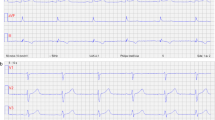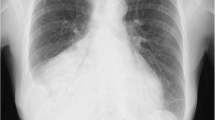Summary
A 56-year-old man suffered from prolonged fever, sore throat and cough, followed by pleural effusion and reversible progressive ascending muscle weakness. The condition fulfilled the diagnostic criteria of Guillain-Barré syndrome. Tuberculosis was initially suspected because of lymphocyte predominance and high adenosine deaminase activity in the pleural fluid. Later, an agglutination titer of 10,240 toFrancisella tularensis antigen was found and an infected hare exposure could be identified. Thus, the activity of adenosine deaminase may be high also in tularemia pleuritis.
Zusammenfassung
Ein 56 Jahre alter Mann litt an langanhaltenden Fieberzuständen, Halsschmerzen und Husten; in der Folge trat ein Pleuraexsudat auf und es entwickelte sich eine zunehmende aufsteigende Muskelschwäche, die sich als reversibel erwies. Der Zustand erfüllt die diagnostischen Kriterien für ein Guillain-Barré-Syndrom. Anfangs bestand Verdacht auf Tuberkulose, da sich in der Pleuraflüssigkeit vorwiegend Lymphozyten und eine hohe Adenosindesaminaseaktivität fanden. Später wurde ein Agglutinationstiter gegenFrancisella tularensis-Antigen von 10 240 entdeckt und Kontakt mit einem infizierten Hasen festgestellt. Hohe Adenosindesaminaseaktivität ist folglich auch bei der Tularämie-Pleuritis zu finden.
Similar content being viewed by others
References
Leneman, F. The Guillain-Barré syndrome. Definition etiology, and review of 1,100 cases. Arch. Intern. Med. 188 (1966) 139–144.
Editorial Guillan-Barré syndrome. Lancet II (1988) 659–661.
Syrjälä, H., Herva, E., Ilonen, J., Saukkonen, K., Salminen, A. A whole-blood lymphocyte stimulation test for the diagnosis of human tularemia. J. Infect. Dis. 150 (1984) 912–915.
Syrjälä, H., Koskela, P., Ripatti, T., Salminen, A., Herva, E. Agglutination and ELISA methods in the diagnosis of tularemia in different clinical forms and severities of the disease. J. Infect. Dis. 153 (1986) 142–145.
Layzer, R.: Neuromuscular manifestations of the systemic diseases.Philadelphia, F. A. (ed.). Davis Company, 1985, pp. 199–204.
Syrjälä, H., Kujala, P., Myllylä, V., Salminen, A. Airborne transmission of tularemia in farmers. Scand. J. Infect. Dis. 17 (1985) 371–375.
Luotonen J., Syrjälä, H., Jokinen, K., Sutinen, S., Salminen, A. Tularemia in otolaryngologic practice. An analysis of 127 cases. Arch. Otol. 112 (1986) 77–80.
Halsted, C., Kulasinghe, H. Tularemia pneumonia in urban children. Pediatrics 61 (1978) 660–662.
Baker, C., Hollis, D., Thornsberry, C. Antimicrobial susceptibility testing ofFrancisella tularensis with a modified Mueller-Hinton broth. J. Clin. Microbiol. 20 (1985) 212–215.
Petterson, T., Riska, H. Diagnostic value of total and differential leukocyte counts in pleural effusions. Acta Med. Scand. 210 (1981) 129–135.
Petterson, T., Ojala, K., Weber, T. Adenosine deaminase in the diagnosis of pleural effusions. Acta Med. Scand. 215 (1984) 299–304.
Ocana, I., Martinez-Vazquez, J., Segura, R., de Sevilla, F., Capdevila, J. Adenosine deaminase in pleural fluids. Chest 84 (1983) 51–53.
Ocana, I., Martinez-Vazquez, J., Ribera, E., Segura, R., Pascual, C. Adenosine deaminase activity in the diagnosis of lymphocytic pleural effusions of tuberculous, neoplastic and lymphomatous origin. Tubercle 67 (1986) 141–145.
Peiris, J., Wickremasinghe, H., Chandrasekara, M. Tuberculous polyradiculitis, Br. Med. J. 4 (1974) 107.
Sutinen, S., Syrjälä, H. Histopathology of human lymph node tularemia caused byFrancisella tularensis varpalaearctica. Arch. Pathol. Lab. Med. 110 (1986) 42–46.
Schmid, G., Catino, D., Suffin, S., Martone, W., Kaufmann, A. Granulomatous pleuritis caused byFrancisella tularensis: possible confusion with tuberculous pleuritis. Am. Rev. Respir. Dis. 128 (1983) 314–316.
Syrjälä, H. Peripheral leukocyte counts, erythrocyte sedimentation rate and C-reactive protein in tularemia caused by the type B strain ofFrancisella tularensis. Infection 14 (1986) 51–54.
Author information
Authors and Affiliations
Rights and permissions
About this article
Cite this article
Syrjälä, H., Kujala, P., Myllylä, V. et al. Guillain-barré syndrome and tularemia pleuritis with high adenosine deaminase activity in pleural fluid. Infection 17, 152–153 (1989). https://doi.org/10.1007/BF01644015
Received:
Accepted:
Issue Date:
DOI: https://doi.org/10.1007/BF01644015




